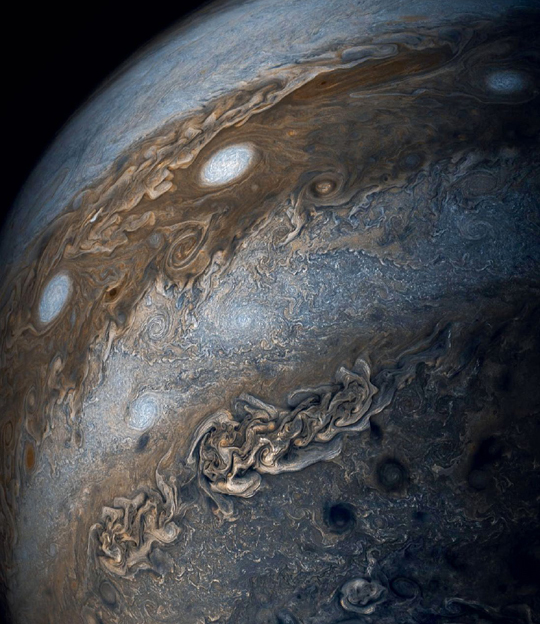2016
Juno at Jupiter
Jupiter has been studied previously by both flyby and orbiter spacecraft, but, for the most part, those missions’ studies of the gas giant planet were only “skin deep.” That is, important questions remain about how Jupiter formed, what its interior structure and composition are like, and what its eventual future is. Since most known extrasolar planets are gas giants that could be similar in many ways to Jupiter, understanding the nature of this world could help us learn about the nature of the worlds around other stars as well.
Thus, NASA chose as its second New Frontiers program mission a robotic probe called Juno, designed to orbit Jupiter and reveal its origin and interior structure. The spacecraft uses enormous solar panels for power (the most distant spacecraft yet to rely on solar power), and carries instruments designed to study Jupiter’s gravitational and magnetic fields, ultraviolet to infrared energy output, and atmospheric properties. The spacecraft was launched in 2011 and went into a highly elliptical polar orbit around Jupiter in July 2016.

Artist’s rendering of the Juno spacecraft in orbit around Jupiter.
Early results from the mission are revealing a much more complex interior and atmospheric structure than previously thought. Swirling, merging, Earth-sized storm systems extend all the way to the previously poorly studied north and south poles of the planet, challenging atmospheric scientists to come up with new models to explain their stability. The nature of Jupiter’s famous colored belts and zones is also proving mysterious, as they appear to extend much deeper than previously assumed. Another surprise has been the discovery that Jupiter’s magnetic field is even stronger than previously thought—more than ten times stronger than Earth’s magnetic field. The “lumpy” rather than smooth shape of the field could mean that it is formed closer to the surface, rather than in the deep metallic hydrogen core. The discoveries will continue as the mission goes on, assuming that the spacecraft and systems can continue to survive the planet’s extremely harsh radiation environment.
SEE ALSO Jupiter (c. 4.5 Billion BCE), Great Red Spot (1665), Jupiter’s Magnetic Field (1955), Pioneer 10 at Jupiter (1973), Galileo Orbits Jupiter (1995).
Complex and enormous storm systems in Jupiter’s atmosphere extend from pole to pole.
